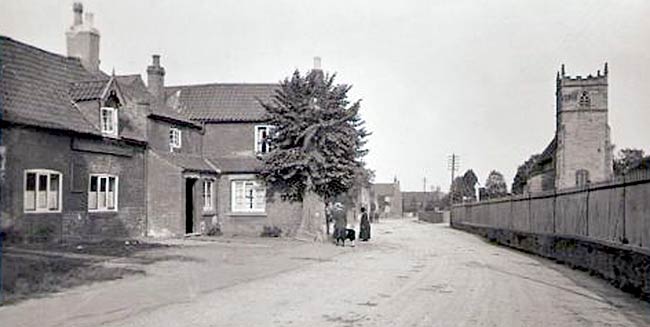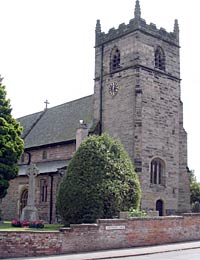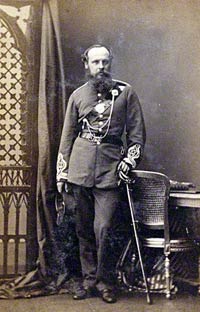< Previous | Contents | Next >
Here Ends a Romantic Tale
WOODBOROUGH. The last resting-place of the most astonishing figure in an astonishing family, and the birthplace of a village evangelist who left the world better than he found it when they laid him in his native churchyard, Woodborough lies in the valley, looking up to hills rich in ancient encampments. Its lovely corner is where the steep hill comes down from the Plains; here roads meet by bright gardens, a fine drive leads to the great house, and a, stream goes on its way to the Dover Beck.

Main Street, Woodborough, c.1910.
Once it was a busy centre of the old stocking knitters, and the rattle of the hand-frames is still heard in some of the cottages. To one of the knitters was born in 1769 a son whose knowledge of the Bible earned him the name of the Walking Concordance. He was George Brown, brought up to be a knitter, but with a thirst for learning which took him to the village school and ended in fifty years of ministry, preaching the gospel from house to house. When he fell ill at Worcester they brought him home to Woodborough, where he died in 1833.

Woodborough Church (2005).
It was the home of some of the Strelleys from the time of Edward the Third to Elizabeth's day, and it is to Richard Strelley that Woodborough owes its crowning glory, the splendid 14th century chancel of the church. While his father was rebuilding Strelley church Richard erected this stately chancel with fine windows, gabled buttresses with grotesque heads on each side, and beautiful sedilia and piscina. Modern days have enriched his 14th century work with a fine gallery of glass, and with fine woodwork.
The great east window (which Richard adorned with heads of his king and queen) has in it the Crucifixion, Paulinus, and St Swithin. In others we see the Madonna between saints, Apostles and Nativity scenes with fine horses and camels and rich gifts, David with his harp, Dorothea with apples, Columba with a church, Chad with Lichfield Cathedral, Hugo with a model of Lincoln, and Cecilia with an organ. The peace memorial window has Gabriel, Michael, and Raphael, and tiny white and gold medallions with the Baptism, the Crucifixion, and the Road to Calvary.
The hand of a clever craftsman is seen in the poppyhead stalls, their shallow canopies carved with quatrefoils in tracery, and in the reading desks with symbols of the Evangelists; the craftsman was Mansfield Parkyns, who, after a life of great adventure, came to live at Woodborough Hall. He spent two years on the work with the help of two joiners, doing all the designing and most of the carving himself. It was a labour of love in memory of his wife, and it proved to be a memorial to himself, for we read that these choir stalls, the last work of his life, were designed, carved, and given on Christmas Eve 1893 by Mansfield Parkyns. He died on January 12, 1894, aged 70. He carved the screen across the tower arch, and designed the pulpit. He sleeps outside the church he helped to enrich.
Except for a few fragments, the rest of the church has nothing of the glory of the chancel. The nave and aisles are later in the 14th century, and the tower is perhaps 16th. Three massive old tie-beams support a mass of timbering in the fine steep roof of the nave, there are fragments of glass 600 years old, and there is a Jacobean altar table given as a thankoffering for the end of the Civil War. Older than all the rest are two 12th century coffin stones, a beautiful Norman doorway with shafts and three orders of moulding, and the Norman font (like part of a round pillar) adorned with bands of zigzag. Two old gable crosses are restored.

Mansfield Parkyns (cropped) by Camille Silvy. Albumen print, 9 April 1861. National Portrait Galley Photographs Collection
NPG Ax52342
It is remarkable to find in this church the work of so romantic a figure as Mansfield Parkyns. Born at Ruddington in 1823 of a distinguished line, he inherited the brain, the brawn, and the unconventionality of his family, so it was in keeping with his qualities that, incurring censure for some mild escapade at Cambridge, he should leave without a degree, and set off for the East as a youth in his teens.
Three years later Sir Francis Galton and a party of friends, after a camel journey across the desert and a voyage down the Nile, reached a collection of mud huts which was Khartoum. They heard of a mysterious European in the town, and going to his hut, entered to find a white man, nearly naked, as agile as a panther, with his head shorn, and with a lepoard skin thrown over his shoulder. One of the visitors immediately recognised the seeming Dervish as a fellow student at Cambridge, Mansfield Parkyns! The wild man had spent three years wandering in Abyssinia with a freedom and fearlessness which no other man had shown since James Bruce.
With all his wildness and wander-lust, Parkyns preserved a saving sanity. "Of the many travellers whom I have known," said Sir Francis Galton, "I should place Mansfield Parkyns as perhaps the most gifted with natural advantages for that career. He won hearts by his sympathy, and could touch any amount of pitch without being himself defiled."
He returned to England after an absence of four years, went out to the Embassy at Constantinople, then returned home once more. He wrote an excellent book on Abyssinia, confirming many of the amazing stories of Bruce; married a daughter of a Lord Chancellor, made an admirable chief official of the Bankruptcy Court; and, still enjoying a reputation as one of the most formidable of amateur boxers, devoted his leisure to woodcarving, to geography, and to the propagation of knowledge of native African and Western Asian languages which, with wonderful facility, he had mastered during his strange journeyings.
